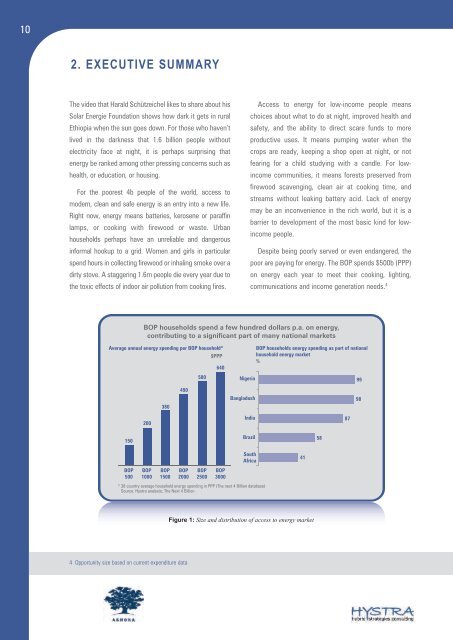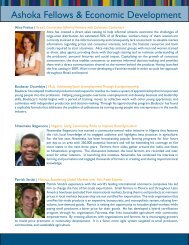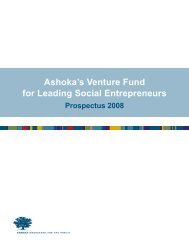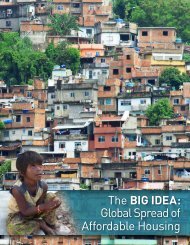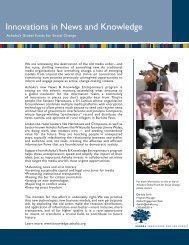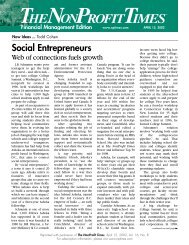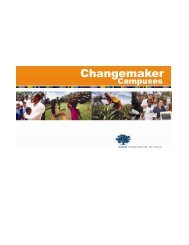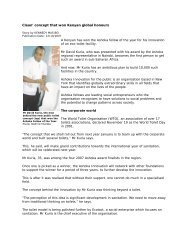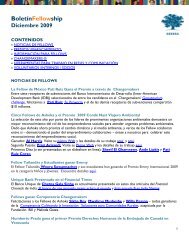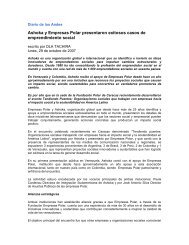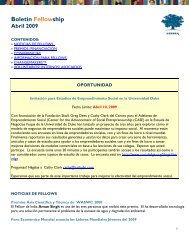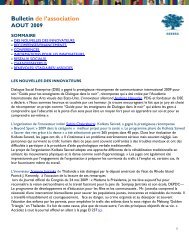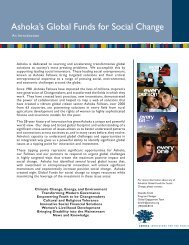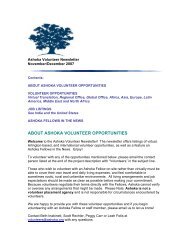Access to Energy for the Base of the - Ashoka
Access to Energy for the Base of the - Ashoka
Access to Energy for the Base of the - Ashoka
You also want an ePaper? Increase the reach of your titles
YUMPU automatically turns print PDFs into web optimized ePapers that Google loves.
10<br />
2. EXECUTIVE SUMMARY<br />
The video that Harald Schützeichel likes <strong>to</strong> share about his<br />
Solar Energie Foundation shows how dark it gets in rural<br />
Ethiopia when <strong>the</strong> sun goes down. For those who haven’t<br />
lived in <strong>the</strong> darkness that 1.6 billion people without<br />
electricity face at night, it is perhaps surprising that<br />
energy be ranked among o<strong>the</strong>r pressing concerns such as<br />
health, or education, or housing.<br />
For <strong>the</strong> poorest 4b people <strong>of</strong> <strong>the</strong> world, access <strong>to</strong><br />
modern, clean and safe energy is an entry in<strong>to</strong> a new life.<br />
Right now, energy means batteries, kerosene or paraffin<br />
lamps, or cooking with firewood or waste. Urban<br />
households perhaps have an unreliable and dangerous<br />
in<strong>for</strong>mal hookup <strong>to</strong> a grid. Women and girls in particular<br />
spend hours in collecting firewood or inhaling smoke over a<br />
dirty s<strong>to</strong>ve. A staggering 1.6m people die every year due <strong>to</strong><br />
<strong>the</strong> <strong>to</strong>xic effects <strong>of</strong> indoor air pollution from cooking fires.<br />
150<br />
BOP<br />
500<br />
200<br />
BOP<br />
1000<br />
380<br />
BOP<br />
1500<br />
490<br />
BOP<br />
2000<br />
4 Opportunity size based on current expenditure data<br />
BOP<br />
2500<br />
BOP<br />
3000<br />
Bangladesh<br />
<strong>Access</strong> <strong>to</strong> energy <strong>for</strong> low-income people means<br />
choices about what <strong>to</strong> do at night, improved health and<br />
safety, and <strong>the</strong> ability <strong>to</strong> direct scare funds <strong>to</strong> more<br />
productive uses. It means pumping water when <strong>the</strong><br />
crops are ready, keeping a shop open at night, or not<br />
fearing <strong>for</strong> a child studying with a candle. For lowincome<br />
communities, it means <strong>for</strong>ests preserved from<br />
firewood scavenging, clean air at cooking time, and<br />
streams without leaking battery acid. Lack <strong>of</strong> energy<br />
may be an inconvenience in <strong>the</strong> rich world, but it is a<br />
barrier <strong>to</strong> development <strong>of</strong> <strong>the</strong> most basic kind <strong>for</strong> lowincome<br />
people.<br />
Despite being poorly served or even endangered, <strong>the</strong><br />
poor are paying <strong>for</strong> energy. The BOP spends $500b (PPP)<br />
on energy each year <strong>to</strong> meet <strong>the</strong>ir cooking, lighting,<br />
communications and income generation needs. 4<br />
BOP households spend a few hundred dollars p.a. on energy,<br />
contributing <strong>to</strong> a significant part <strong>of</strong> many national markets<br />
Average annual energy spending per BOP household* BOP households energy spending as part <strong>of</strong> national<br />
$PPP<br />
640<br />
household energy market<br />
%<br />
580<br />
Nigeria<br />
99<br />
India<br />
Brazil<br />
South<br />
Africa<br />
* 38 country average household energy spending in PPP (The next 4 Billion database)<br />
Source: Hystra analysis; The Next 4 Billion<br />
Figure 1: Size and distribution <strong>of</strong> access <strong>to</strong> energy market<br />
41<br />
58<br />
87<br />
98


